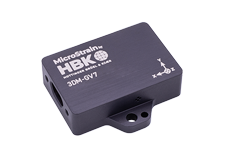FAQs
Videos
Uploads to SensorCloud are typically dominated by the data content, with minor additional overhead for secure communications. One simple method to estimate upload bandwidth is to multiply the number of samples to be uploaded by 12 bytes. Each uploaded sample contains an 8 byte field for the timestamp, and a 4 byte field for the value. Example: If you have three nodes with one channel active all sampling at 32 Hz, your effective upload rate would be 96 samples per second. Multiplying by 12 bytes per sample, this amounts to 1,152 bytes per second. This amounts to 2,985,984,000 bytes over the course of a month, or approximately 2.78 GB.
Yes, the WSDA-Base-101 can indeed be powered by both power sources at the same time. The base station will use whatever power source has the higher voltage.
Please refer to page 29 of the WSDA-Base-101 user manual: http://files.microstrain.com/WSDA-Base-101-Analog-Output-Base-Station-User-Guide.pdf
In a word, no. Precise Point Positioning is a Global Navigation Satellite System (GNSS) positioning method to calculate very precise positions up to few centimeter level using a single (GNSS) receiver in a dynamic and global reference framework like International Terrestrial Frame (ITRF). The 3DM-GX3-45 is not capable of this precision.
If you are using the standard cable type supplied with the DVRT sensors, 20 feet is the maximum for M-DVRT and MG-DVRT, and 60 feet is the maximum for S-DVRT, SG-DVRT and NC-DVRT. If you require longer cable lengths, LORD MicroStrain® can provide custom cables of lower resistance.
No, carbon fiber has not been shown to pose a problem.
Yes, as a courtesy, LORD MicroStrain® will provide an appropriate drill bit and tap to match the DVRT's thread size at a nominal charge.
In most cases, MicroStrain calibrates every DVRT with its accompanying electronics and provides a detailed calibration certificate. The certificate provides 3 methods of calibration and all the particulars including formulas to resolve voltage into engineering units.
- Standard Least Squares Linear Fit provides a simple mathematical method to convert sensor output to displacement and delivers reasonable accuracy.
- Polynomial Fit provides a more mathematically intensive method to convert sensor output to displacement and in turn delivers a high degree of accuracy. A possible drawback to some users of this method may be that it can not accurately report measurements beyond its stroke length (i.e., over-stroking).
- Multi-Segment Linear Fit provides the most mathematically intensive method to convert sensor output to displacement, delivers a high degree of accuracy and is not subject to the drawback of over-stroking.
- Body length to stroke ratios for DVRTs are typically 2.5 to 1 as compared to 6 to 1 for LVDTs.
- Microminiature DVRTs are available in body diameters of only 1.5 mm (.060") and with core diameters of only 0.5 mm (.020"); this makes them the World's smallest commercially available linear displacement transducers.
- DVRTs maintain their temperature stability due to the use of two coils arranged differentially.
- Each DVRT is capable of submersion as a standard feature.
- Each DVRT can be hermetically sealed as an option.
- Microminiature DVRTs are available with super-elastic, nickel titanium cores.
- DVRTs have a standard operating temperature range up to 175 degrees C; LVDTs typically only operate up to 85 degrees C.
- DVRTs have been operated successfully in liquid nitrogen; LVDTs typically only operate to -20 degrees C.
The output is an analog DC voltage proportional to linear displacement. The full scale voltage is optionally +/-5 volts or 0-10 volts. The analog voltage is easily read using a multi-meter or DAQ. The voltage can also be read in the digital domain by using LORD MicroStrain® Smart Motherboards. These Smart Motherboards provide a data gateway to PC-based software or to user-programmable LCD displays on the motherboard itself.
Yes. DVRTs can be used in wet environments. One of our customers uses the DVRT to measure mussel growth on the ocean floor. An automotive customer uses the DVRT in a hot oil environment for under-the-hood testing. Our orthopaedic customers use the DVRT for soft and hard tissue testing (in vivo and ex vivo) in cadaver and animal studies.










